May 17, 2025 | 09:54 GMT +7
May 17, 2025 | 09:54 GMT +7
Hotline: 0913.378.918
May 17, 2025 | 09:54 GMT +7
Hotline: 0913.378.918
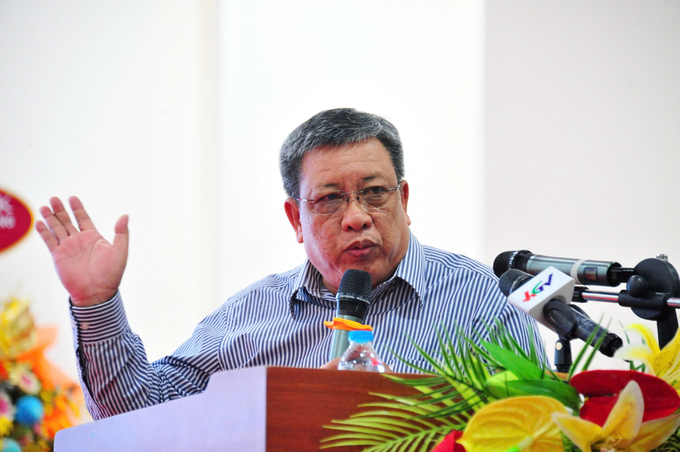
Mr. Le Thanh Tung, Deputy Director of the Department of Crop Production (MARD). Photo : Le Hoang Vu.
Mr. Le Thanh Tung, Deputy Director of the Department of Crop Production (MARD), presented the following at the Workshop on October 25: "Linking the rice value chain to contribute to the implementation of the project on1 million ha of high-quality, low-emission rice attaching to the green growth of the Mekong Delta by 2030."
In the past, the Department of Crop Production has constructed seven prototype models in five provinces: Kien Giang, Soc Trang, Tra Vinh, Dong Thap, and Can Tho city. These localities are representative of three sub-ecoregions (high, middle, and low) and three distinct soil characteristics (alluvium, salty alluvium, and fresh alluvium) in the Mekong Delta.
Mr. Tung asserts that the pilot models must adhere to Decision No.145 of the Department of Crop Production, which pertains to the issuance of a process and the guide on the "technical process of producing high-quality, low-emission rice in the Mekong Delta." Consequently, the process incorporates the most suitable techniques from relevant processes, including local and foreign research results, successful models in practical and expert knowledge, and local experience, to guarantee that the prototype models are efficient and as anticipated.
The process is inclusive of all stages of rice production and is divided into three components: cultivation techniques, harvesting and post-harvest processing, and straw management. These components are interconnected and unified, resulting in a completed and synchronized rice production system in the region under the Project. Furthermore, the process establishes a standardized "formula" for farmers who are participating in the pilot model, outlining techniques for cultivation, soil preparation, water management, integrated insect management, and more.
Seed utilization can be reduced by 30-50%, which is equivalent to 30-80 kg/ha, by utilizing row and cluster sowing techniques in conjunction with fertilization. This method reduces resource waste, limits plant density, decreases nutrient competition, and increases yield, while also saving costs ranging from 0.6 to 1.6 million VND/ha.
The application rate of nitrogen fertilizer is decreased by 30-70 kg/ha, resulting in savings of 0.7 to 1.6 million VND/ha.
Theoretical productivity from the models indicates substantial development in terms of economics and yield. At the Vinh Thanh (Can Tho) and Long Phu (Soc Trang) facilities, the OM5451 and ST25 varieties respectively produced 3.9-7.5% and 8.9-13.7% more than traditional models. These models exhibit a highly positive economic efficiency, as evidenced by net profit increases of 13 to 18 million VND/ha in the summer-autumn 2024 harvest and 1 to 6 million VND/ha in the autumn-winter 2024 crop.
"The area under cultivation has expanded, and the rice yield has'surged' without the need to consult the community." Mr. Tung observed that this is the result of effective pest management and sparse cultivation.
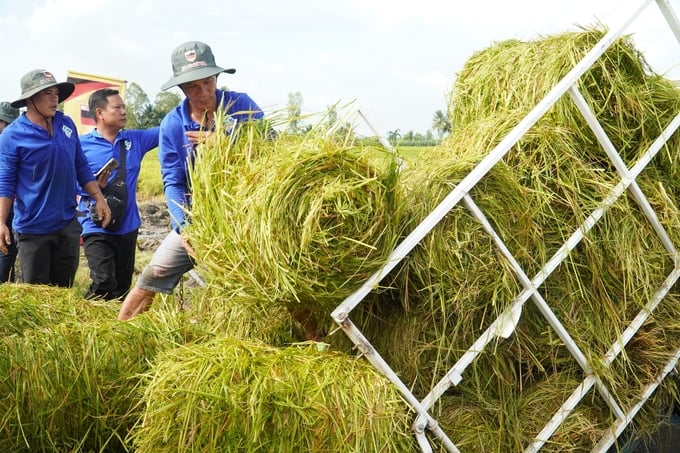
Promoting the removal of straw from fields is one of the effective measures to reduce greenhouse gas emissions. Photo: Kim Anh.
In Soc Trang, the prototype model has emissions of 9.5 tons CO2e/ha/crop, while emissions outside the model can reach up to 13.5 tons CO2e/ha/crop, indicating a difference of nearly 4 tons CO2e/ha/crop in terms of greenhouse gas emission reduction. In Tra Vinh, the average emission in two pilot models that employ the low-emission rice production technique is approximately 7.6 tons CO2e/ha/crop. However, the emission disparity is approximately 5.4 tons CO2e/ha/crop outside the model while it exceeds 13 tons CO2e/ha/crop.
The International Rice Research Institute (IRRI) and other institutes under the Ministry of Agriculture and Rural Development have measured and reported these emission reduction results to the Crop Production Department.
Mr. Tung underscored that the objective of low-emission rice cultivation is not to determine the sale of carbon credits. In accordance with the roadmap, the Ministry of Natural Resources and Environment will provide the Government with an official report on the carbon credit commercialization mechanism by 2028. Consequently, the 1 million hectare rice project is designed to restructure production, improve the prosperity of rice farmers, and improve the quality of life for rice cultivators by enhancing cooperative capacity, building farmland, and developing infrastructure.
The Deputy Director of the Crop Production Department also addressed critical issues in rice production in the Mekong Delta during the workshop. These issues include the need for intensification to ensure that the area, yield, and output are maintained while simultaneously reducing production costs, increasing value, and enhancing farmer profits. These concerns also pertain to the degree of adaptability to climate change without adverse environmental consequences. Land, water, and other natural resources must be utilized sustainably for the Mekong Delta to accomplish this.
Additionally, the utilization of equipment, mechanization, and science and technology that are appropriate for the region's production conditions will help enhance efficiency. Achieving green growth through circular rice agriculture, assuring food security, and building a value chain are critical components.
Mr. Tung underscored the importance of technologies and techniques that can enhance the efficacy of fertilizers, such as the combination of row or cluster sowing and fertilization. Furthermore, it is imperative to adhere to fertilization protocols to prevent over-fertilization, incorrect application, or the application of fertilizer that does not align with the plant's requirements. Establishing fertilizer application guidelines and management tools that are customized to specific regions is imperative.
To achieve these objectives, robust databases are imperative, including fertilizer utilization maps for rice by crop season and ecological subregion, climate risk maps and adaptation plans (CS MAP), and resource management maps for soil, nutrients, and water. Additionally, efforts should concentrate on administering nutrients specific to a particular region.
Translated by Linh Linh
![Multi-channel, multi-directional Vietnamese agricultural markets: [7] Deep processing makes global reach easy](https://t.ex-cdn.com/nongnghiepmoitruong.vn/608w/files/huytd/2025/05/16/2946-che-bien-sau-chia-khoa-vang-nang-tam-nong-san-viet-tren-ban-do-the-gioi-080603_110-093858.jpg)
(VAN) The application of deep processing technology is helping Vietnamese agricultural products enhance their value, create competitive advantages, and open doors to conquer global consumers.
![Multi-channel, multi-directional Vietnamese agricultural markets: [6] Agri products go online](https://t.ex-cdn.com/nongnghiepmoitruong.vn/608w/files/content/2024/12/10/1-113313_954.jpg)
(VAN) Bringing agri products onto e-commerce platforms is an effective way to build a brand that many businesses, cooperatives, and agricultural production households are doing.
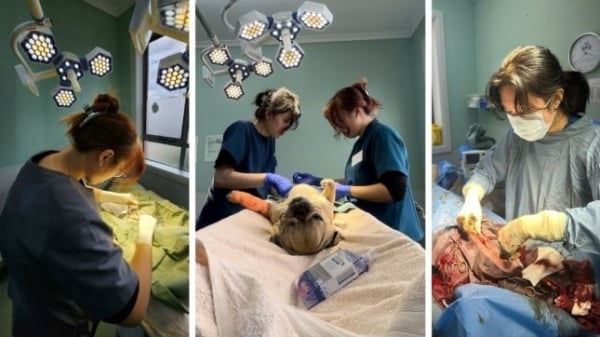
(VAN) Veterinary training should focus on quality, not just quantity. Veterinarians also need more options to pursue specialized training.
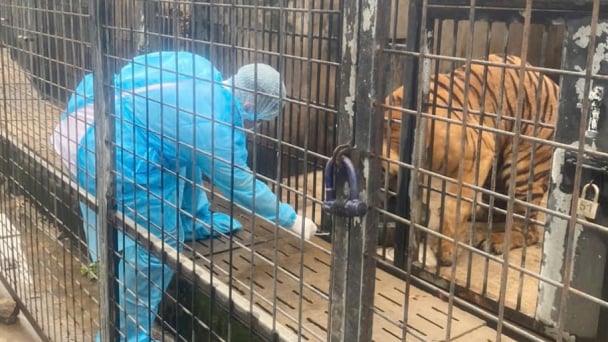
(VAN) The veterinary industry needs to be viewed objectively and further invested in to properly demonstrate its role and importance in the new context.

(VAN) The number of veterinarians graduating each year is not enough to meet actual needs, hence a difficult problem for the growing livestock industry.
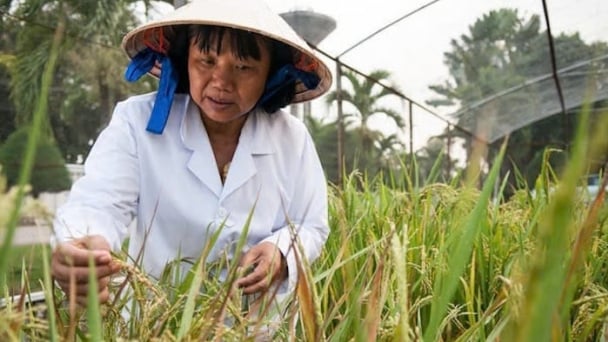
(VAN) The strategic partnership between Cambodia, the Philippines, Vietnam, and CGIAR ensures that innovative solutions effectively address national priorities for food system development.
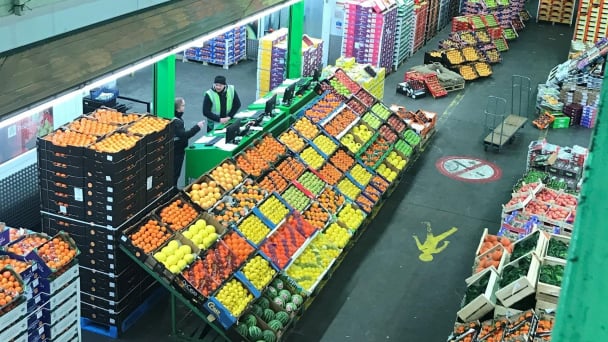
(VAN) This was affirmed by the UK Minister of State at the Department for Environment, Food and Rural Affairs during a working session with Deputy Minister Tran Thanh Nam on May 13.